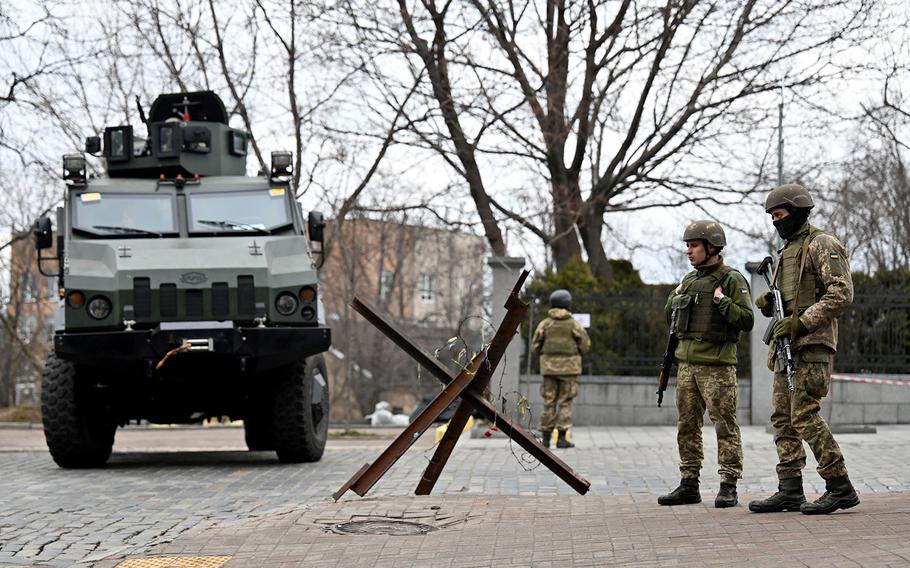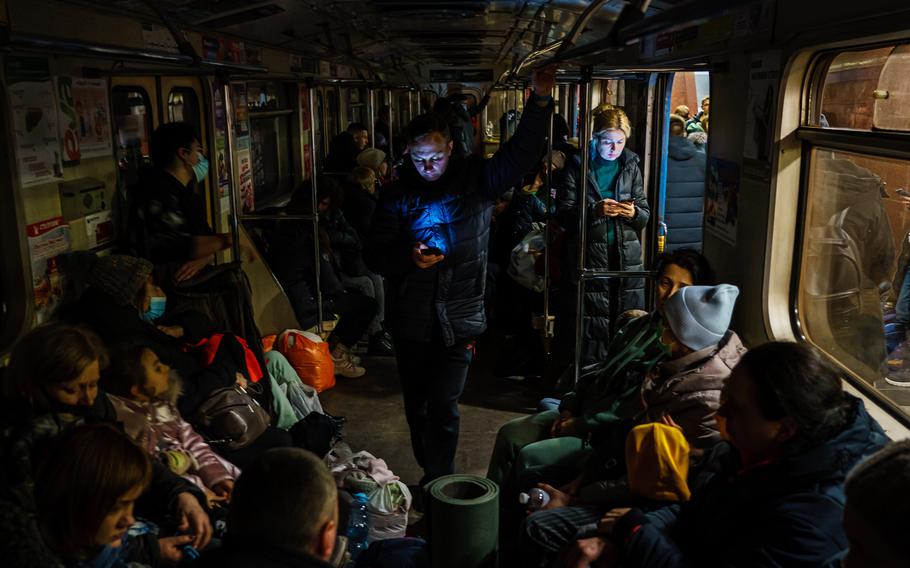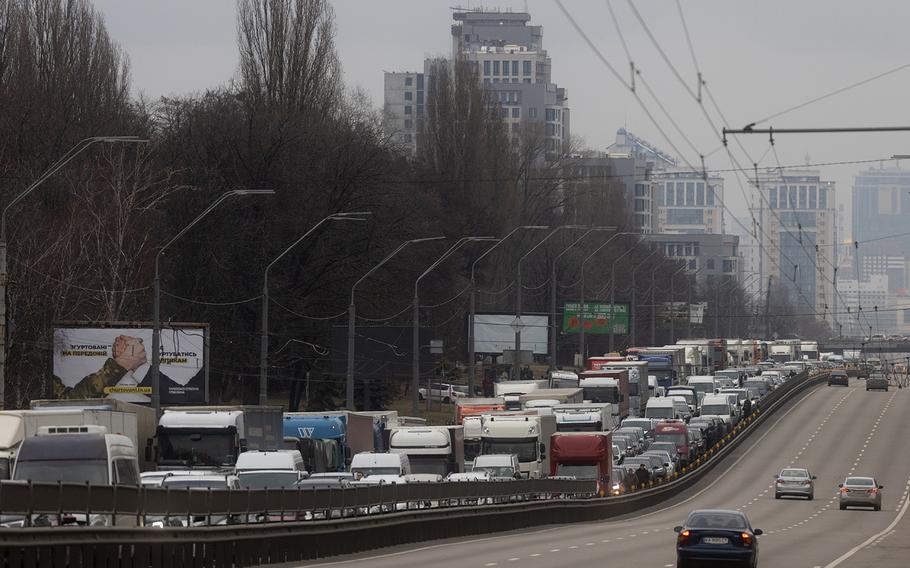Europe
Russia widens its attack on Ukraine: ‘We now have war in Europe’
Los Angeles Times February 25, 2022

Ukrainian Military Forces servicemen block a road in the so-called government quarter in Kyiv on Feb. 24, 2022, as Russia's ground forces invaded Ukraine from several directions today, encircling the country within hours of Russian President Vladimir Putin announcing his decision to launch an assault. (Sergei Supinsky/AFP)
KHARKIV, Ukraine (Tribune News Service) — Moscow accelerated its assault on neighboring Ukraine on Thursday, with explosions resounding in cities across the country, airstrikes crippling defenses and reports of troops crossing borders by land and sea as Russian forces pressed closer to the Ukrainian capital, Kyiv, and citizens fled on clogged highways and took cover in subway stations.
It was uncertain how long the Ukrainian army could hold back a blistering onslaught by Russian forces that included missiles, heavy artillery and cyberattacks. But with brisk Russian advances from the south, north and east, it appeared Russian President Vladimir Putin had his sights set on not just on taking eastern Ukraine but also on conquering a former Soviet republic turned U.S. ally and perceived threat to Moscow.
“We now have war in Europe on a scale and of a type we thought belonged to history,” NATO Secretary-General Jens Stoltenberg said Thursday, describing the incursion as “a deliberate, coldblooded and long-planned invasion” and a “blatant violation of international law.”
The Russian invasion — with an estimated 190,000 troops massed around Ukraine — targeted strategic military sites and swept much of the nation.
Russian missiles struck Ukrainian military command centers, air bases and depots in the capital, Kyiv, and in the major cities of Kharkiv and Dnipro, an adviser to Ukraine’s interior minister said on Facebook.
The government acknowledged that Russian forces had taken control of Chernobyl, the city north of Kyiv that was the site of the world’s worst nuclear accident, raising fears of a possible leak of radioactive material. Ukraine’s Interior Ministry also confirmed that Russian troops had seized a strategic international airport barely 10 miles outside Kyiv.
Russia has “every intention” of decapitating Ukraine’s government, a senior Pentagon official said, calling Thursday’s offensive a likely prelude to a direct assault to overthrow the Ukrainian government.
“What we’re seeing are initial phases of a large-scale invasion,” said the official, who briefed reporters on condition of anonymity to discuss sensitive details.
In Washington, President Joe Biden described the onslaught as a “premeditated attack” that came “without provocation, without justification, without necessity.” He laid responsibility for it firmly on Russian President Vladimir Putin, calling the conflict “Putin’s war.”
Russia’s three lines of attack include a southern advance, from the Crimean peninsula, stretching north to the city of Kherson. Another assault extended from north-central Ukraine to the south, “basically from Belarus to Kyiv,” the Pentagon official said. The third is from northeastern Ukraine to the south.
There was no definitive word on casualties. Civilians took shelter in their homes, subway stations and elsewhere, while some headed for the country’s borders. Lines formed at banks as people hastened to withdraw cash from their accounts. Both the United States and the North Atlantic Treaty Organization moved to bolster the alliance’s military presence, though Biden said there was no plan for troops to become involved in Ukraine, which is not a NATO member.
The Pentagon ordered the deployment to Germany of 7,000 additional service members in a move intended “to reassure NATO allies, deter Russian aggression and be prepared to support a range of requirements in the region.”
NATO also said it was sending additional land, air and maritime assets to its eastern flanks in a bid to enhance its ability to “respond to all contingencies,” the alliance said.
Huge traffic snarls formed as residents tried to flee the capital. Video showed Russian armored vehicles advancing into mainland Ukraine from Crimea, the peninsula that Moscow seized eight years ago. Ukrainian air-traffic controllers sealed off the country’s airspace “due to the high risk ... for civil aviation.”
President Volodymyr Zelenskyy declared martial law in his beleaguered nation and encouraged his compatriots to take up arms. Meanwhile, the U.S. and the West announced additional sanctions on Russia for an invasion that they had warned for weeks was coming but that Moscow had denied was planned.

Hundreds of people seek shelter underground, on the platform, inside dark train cars, and even in the emergency exits, in metro subway station as the Russian invasion of Ukraine continues, in Kharkiv, Ukraine, Thursday, Feb. 24, 2022. (Marcus Yam//Los Angeles Times)
Putin portrayed the incursion — which followed months of Russian military buildup along Ukraine’s borders to the north, east and south — as a move to liberate and protect eastern Ukraine, where Moscow-backed secessionists hold sway over a large swath of the region. He warned other countries to not intervene, saying that it would lead to “consequences you have never seen in history.”
Biden conferred with other world leaders Thursday to try to coordinate a response to an act of aggression that has drawn outcry across the globe and that raised the specter of catastrophic bloodshed in Europe.
The attack rattled Europe and stirred memories not only of the Cold War but also of World War II. It reflected Putin’s long mistrust of NATO and the West and his ambition to stitch back together remnants of the former Soviet Union. And it raised the specter of how the West — let alone Ukraine — would handle a possible humanitarian and refugee crisis while trying to counter a powerful Russian military that possesses conventional and nuclear weapons.
“This is a grave moment for the security of Europe,” said Stoltenberg, the NATO secretary-general, who will convene an emergency virtual summit of alliance leaders Friday. “Russia’s unjustified and unprovoked attack on Ukraine is putting countless innocent lives at risk with air and missile attacks, ground forces and special forces from multiple directions, targeting military infrastructure and major urban centers.”
An adviser to Zelenskyy said Russian forces had seized Chernobyl, where a reactor exploded in April 1986, spewing radioactive materials across Europe. The stricken nuclear plant has since been decommissioned and the damaged reactor encased in a giant concrete-and-steel shelter, but Ukrainian authorities warned that fighting could damage the covering.
“After the absolutely senseless attack of the Russians in this direction, it is impossible to say that the Chernobyl nuclear power plant is safe,” Zelenskyy aide Myhailo Podolyak told the Associated Press.
Washington and its European allies announced more sanctions aimed at further isolating Russian banks, oligarchs and companies from world markets, measures going beyond similar steps taken earlier this week.
Putin announced his “special military operation” in eastern Ukraine in a nationally televised address early Thursday in Moscow.
Even as he spoke, bombing runs began across the former Soviet republic, with about two dozen strikes reported on major cities and other areas. An adviser to Zelenskyy said that more than 40 Ukrainian soldiers had been killed and dozens more wounded in fighting.
Russia’s Defense Ministry said in a statement, quoted by the Russian Interfax news agency, that Ukrainian air defenses were “suppressed.”
The Russian news agency Tass reported that Russian strikes “crippled” 74 Ukrainian military facilities, including 11 airfields, a navy base and 18 radar stations housing missile systems. All goals set for Thursday “have been successfully fulfilled,” Defense Ministry spokesman Maj. Gen. Igor Konashenkov told reporters in Moscow.
Ukraine’s Defense Ministry said its forces shot down five Russian warplanes and a helicopter, an assertion denied by Moscow.
Russian military vehicles were reported to have entered Ukraine from Belarus to the north, where Russian troops had been holding joint military drills that Western capitals warned were a prelude to an incursion. Kyiv lies barely 50 miles south of the Belarusian border.
On Wednesday, before Thursday’s large-scale incursion, Western powers said Russian soldiers had already entered Ukraine from the east, in the industrial heartland known as the Donbas, where Moscow’s proxy militias have engaged in battles with Ukrainian forces for eight years, costing thousands of lives. Putin on Monday recognized two Donbas enclaves under the control of pro-Russia separatists, Donetsk and Luhansk, as independent republics, setting the stage for him to send in troops to the region as “peacekeeping” forces.
Here in Kharkiv in northeastern Ukraine, the country’s second-largest city, Ukrainian soldiers stood in a field with two Howitzers aimed north, where the Russian border lay. A convoy of large Ukrainian military trucks lumbered down the road.
Almost all shops were closed. In the lobby of the high-end Kharkiv Palace Hotel, guests sipped coffee, wondering whether they should join the westward exodus.
“The Russians will be here in two hours,” said a man who gave his name as Anton, who had come to Kharkiv on a work trip and was trying to find a way to return to Kyiv. The road heading southwest to the city of Dnipro was not an option, he said, as he expected it to be bombed by the Russian military.
Some residents flocked to subway stations looking for escape or for shelter, lugging backpacks, small suitcases and pet carriers. Inside one station, people wedged themselves against the wall, using their bags to claim what little space they could as the crowds kept piling in. Those who could cram themselves into subway carriages did so, sitting on the seats, the floor or anywhere else they could find, waiting in darkness for the train service to start up.
Standing in the middle of a subway platform was Sergei, 30, a real estate agent turned programmer who was carrying his baby daughter, Naomi.
He wasn’t scared for himself, he said, but for Naomi. His wife, Katya, agreed, saying that they were trying to leave “not because we’re not patriots, but because we have a child. … If it wasn’t for her I would go fight.”
As the day had worn on, the couple, who gave only their first names for fear of their safety, discussed whether they should try to get out of the city. There were no planes, no trains. Should they take a car and risk the traffic — not to mention the possibility of encountering Russian soldiers — on intercity roads?
“We just don’t know. There are too many rumors,” Katya said.
Another individual seeking refuge in the station, also named Sergei, expressed disbelief at his family’s predicament. His daughter, 4, his wife and his mother sat on pink and blue yoga mats spread out on the floor of the platform.
“This is the 21st century. I just can’t believe this is happening,” the 38-year-old marketing manager said, looking around at people threading their way through the crowds, as if they were extras in a film.
“Not a World War II movie,” Sergei said. “A horror movie.”
Outside, Nasruddin Nooruldin, a 23-year-old medical student from India, stood among a gaggle of other international students, all of them looking anxious.
“We’re hoping to get an evacuation flight,” he said. “There are hundreds, maybe even more than 1,000 of us from India here.”

Cars sit at a standstill as people try to leave the city on Feb. 24, 2022, in Kyiv, Ukraine. Overnight, Russia began a large-scale attack on Ukraine, with explosions reported in multiple cities and far outside the restive eastern regions held by Russian-backed rebels. (Chris McGrath/Getty Images)
Earlier in the Donbas town of Slovyansk, about 75 miles north of Donetsk, the sound of explosions filled the morning air, but residents appeared to remain calm. As the sun rose, some emerged to start their workdays, albeit under tense circumstances.
“We’re going to stay open,” said Bogdan, an 18-year-old barista, as he slipped an almond croissant into a paper bag and handed it to a waiting customer at a cafe. “For now we’re waiting.”
Anton Chechenko, 30, an electric engineer who works in Slovyansk but whose family lives in Dnipro, about four hours’ drive to the west, stood in the central square and watched a flock of pigeons strut on cold tiles.
“Everyone here has lived through war. And we’re not seeing shelling yet,” he said. Besides, he added, “fear isn’t something that can save your life or your health. You need calm for that.”
The most visible sign at that hour of any distress was at banks and gas stations, where queues formed in the early morning and persisted as the day wore on. Alexander, 30, who gave only his first name, stood near a bank talking to an army officer on the street. He had just come back from the store and had loaded his backpack with canned food and other supplies.
He planned to go to a village near Kharkiv, to the northwest. “It will be calm there,” he said.
Shortly after he spoke, Zelenskyy announced that Ukraine was formally severing ties with Russia, which had earlier pulled out its diplomatic personnel from Kyiv, before the invasion began. Zelenskyy exhorted “those who have not yet lost their conscience” in Russia to go out and protest against the incursion.
“As of today, our countries are on different sides of world history,” Zelenskyy tweeted. “Russia has embarked on a path of evil, but Ukraine is defending itself and won’t give up its freedom.”
The assault negated weeks of frantic diplomacy to try to prevent war — and indeed came as the United Nations Security Council was in the midst of discussing the crisis in an extraordinary session.
It shatters a two-decade stretch of relative peace in Europe, which survived two world wars and a cold one in the 20th century. Even some seasoned analysts of contemporary Russia were stunned by Putin’s decision to move in, despite all the signs pointing to just such an intention.
The West is now under heavy pressure to present a united front not only in its rhetoric but also in the severity of penalties it is willing to inflict on Russia — and, as a consequence, on some of its own economies, particularly in Europe. Germany took a significant step toward that goal Tuesday when Chancellor Olaf Scholz announced that his government was halting authorization of the Nord Stream 2 pipeline project to bring Russian gas westward.
Much of Europe relies on Russian gas to heat homes and generate electricity. More than one-third of the gas consumed by the 27-nation European Union is imported from Russia, making some member nations nervous about a major confrontation with Moscow. The Biden administration says it has been working with European partners to secure other sources of energy for the Continent, although a rise in prices would be an inevitable result.
(Bulos reported from Kharkiv, Chu from London and McDonnell from New York. Times staff writers Sarah D. Wire and Anumita Kaur in Washington contributed to this report.)
___
Visit at latimes.com.
Distributed by Tribune Content Agency, LLC.